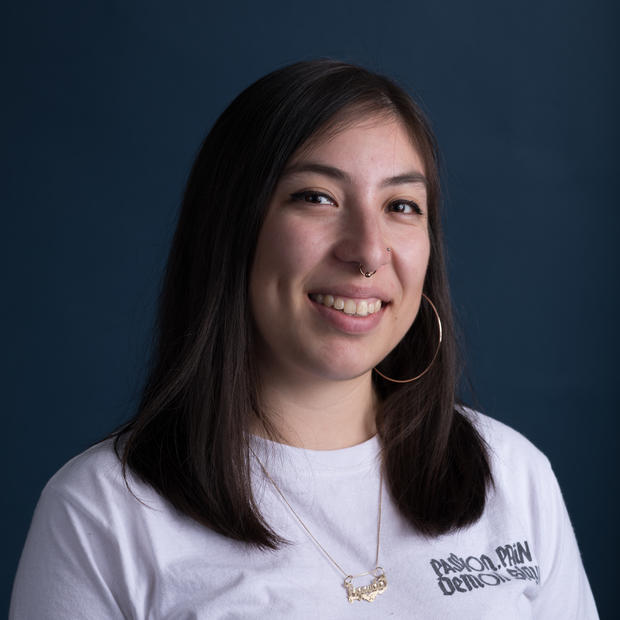In addition to being one of the last all-ages music venues in the city, Vera offers audio engineering training, silk screening and other art making opportunities to youth 14-24. So it helps that Hasham is somewhat of a pro at code switching. He talks with young people still in pursuit of finding themselves, but can also champion their needs and desires to people in positions of power.
Starting today, he finds himself in a new position of power, as the new youth arts manager at the Seattle Office of Arts and Culture (OAC). He’ll guide programs such as The Creative Advantage, which provides equitable arts education in Seattle schools, and build partnerships with creative industries to encourage youth toward art careers.
Before working at Vera, Hasham worked at TeenTix, a program that gives teens 13 to 19 years old access to Seattle arts venues for $5, and educates aspiring writers in its press corps. He also did a brief stint in Chicago where he helped build a similar youth arts accessibility program.
Building genuine relationships with youth is key to Hasham’s success. Whether through his footwear or his use of the word “hella,” he stays in tune with young people, particularly locals.
It’s partially why the 29-year-old scored his new gig.
“I love that he graduated from Ballard High School,” OAC Director Randy Engstrom said of Hasham’s hire. “He’s from here, he has deep, lived experience and relationships here over many years.”
At The Vera Project last week, in his teal office decorated with graffiti, trendy rock stickers and a chalkboard wall, Hasham wondered if a city job will force him to code switch more often — and whether he can get away with wearing his spunky outfits.
(On this day he wore corduroy pants with little embroidered elk, a shirt with a black-and-white photo of Wu Tang Clan’s Ghostface Killah on a bullet train, a teal cardigan and purple-and-orange Nike sneakers. To top it off, his nails flashed gold with polish.)
“It’s a matter of reality, but maybe I’ll have to code switch more with the city, maybe I won't have to, I don't know,” Hasham said.
Crosscut caught up with Hasham to ask about how he’ll employ his dope sense of fashion, deep connections with the city’s creative institutions and passion for art to help the city serve its children, teens and young adults.
This interview has been condensed and edited.
Why do you think you got this position at OAC?
I got hired because I've been working with young people in Seattle for a long time in the art community. I'm like hella networked. That's kind of one of my superpowers: building relationships and gaining trust. And then displaying my enthusiasm for what I'm talking about. That enthusiasm then translates into a passion that translates into a good reason to get shit done because it feels good.
When you were attending Ballard High School, did you ever imagine yourself leading arts organizations?
Kind of. Through TeenTix I [started going to] the ballet and the opera when I was 16 or 17. I was wearing nice clothes, putting on a tie. I was a kid who went to Value Village and Goodwill all the time and was dressing kind of funky. I had funny ties that matched my shoes and whatnot. I was like “I kind of want to be one of these people.” This is young me trying to be “boujee.” I was trying to be one of these people who knows what a cabernet is versus a merlot. I don't really care as much anymore, but there is that sense of power alluded to with that, that I was attracted to for sure.
Why do you think you were attracted to that?
Probably because I'm an immigrant. I was born in Pakistan and moved here when I was 9 months old, so part of that was trying to get something I didn't have access to. Through opportunities like TeenTix and Vera, and through Seattle Public Schools, I got a lot of arts education and exposure to what this field could be.
When did you realize you wanted to work with younger people?
I started at the Henry Art Gallery right after college at 22 and then I just kept going. Come in early, stay late, get the job done, make sure I'm doing it as well as I can and then leave the place better than I found it. By modeling that, working with young people just came easy because they're in the same mindset of trying to grow how they will exist in the world for the next X number of years.
What's considered a youth?
[At Vera it’s] 14 to 24. It's a pretty wide range. There's this term that's been trending called “opportunity youth.” It’s like 18 to 26; young people who never really found their career path through their high school channels or their typical institutional channels. There's still a level of support some folks need or want.
Why do you think art is important for young people?
Art is not just to feel good, it’s a social catalyst for change — certainly with young people, who are coming forward in a way that we've seen time and time again throughout history. In this case, through climate change and gun violence. There are so many different areas in which young people are influencing the world that we need to be recognizing in and investing in. Seattle is one of those places [where] we can make those investments and be a model.
What are you going to miss about Vera?
The radical creativity that happens here all the time. Being able to change the programs, the walls, the cost of the classes — we can change all of that to reach community needs and we do that hella nimbly. With a really small staff, we can change direction on a dime. Bureaucracy is not that way, for sure.
Are there ways OAC has invested in youth and arts that get you excited?
It certainly has with Creative Advantage, the arts education initiative through Seattle Public Schools, which my predecessor Lara Davis established six years ago. It won awards nationally for working with big bureaucracies and tons of community partners to have a collective impact, where you're actually getting arts education to every single young person in Seattle Public Schools. In 2020 we’ll have seen it go through every single school. The opportunity there is how you keep it funded, how do you keep the momentum going. That's going to be a challenge I am stoked to help solve. There's some new stuff in the job too: How to get young people connected to careers in the creative industries. Those things are already appealing to young people, but how do you make them a goal you can actually work toward achieving in the city.
How do you stay connected with young people?
Sneakers are always a good talking point. That's to say “if he's wearing approachable shoes maybe he's aight.” Saying words like hella works too, it's not stuff I necessarily try to do, but upon reflecting on it I think it works working with young people. And just treating them like a regular person. Young people are given advice when they didn't even ask for advice. You gotta take a step back to take two steps forward. I think it's worthwhile because I don't know everything and I’ll be the first person to tell you that. That’s part of what makes me an interesting leader [and] what I'm excited about. This [job] is actually being a funnel for folks who are doing the work on the ground, who are seeing the realities of young people in different parts of the city and county.
Any other arts organizations you admire for the way they’re reaching youth?
I love what Community Arts Create is doing. They're out of the Hillman City Collaboratory. I was just at their gala and they have a program called the Rhapsody Project. It’s young people learning about folk music and Americana. There were seven young people — probably high school or under — and they did a dope 1930s song that had a rhythm section and a couple of fiddles. It’s something you wouldn't see young Black and brown children singing, but they were, and it was so beautiful and so good and got me excited about the next generation of people who are learning about the history of American music in a way that I didn't know was worth learning about. That's what cool arts education does, it teaches you what you didn't know was essential, or a metaphor for something that is relatable now in the world.
Get the latest in local arts and culture
This weekly newsletter brings arts news and cultural events straight to your inbox.



